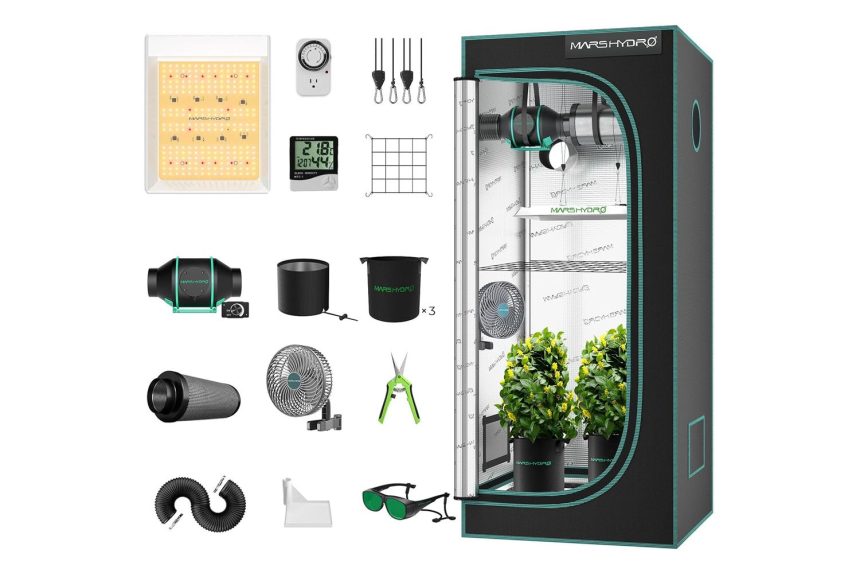The idea of setting up a grow tent inside your house might seem intense if you’re not a seasoned grower, but it’s a rather practical piece of equipment for many gardeners.
Maybe your living space is poorly lit, or you don’t have outdoor space, or your favorite plants can’t grow in your plant hardiness zone. A grow tent can solve all of these common problems by acting as a greenhouse of sorts where conditions are perfect for plants to thrive, so you can grow whatever you want all year round.
Aaron Steil, consumer horticulture extension specialist at Iowa State University, says that thinking ahead is the key to choosing the best grow tent for your plants.
“Understanding the mature size of the plant and the size of the room you plan to put the tent is essential to getting the most appropriate size,” he explains. “Make sure the plants have enough space to reach their full height and width without being overly crowded.”
Grow tents come in many sizes—some can sit comfortably on a countertop while others can take up a whole room. The grow tents we tested come in a variety of widths, depths, and heights so you can choose one that’s just-right for your space.
“For many gardeners you will want to buy the largest tent that fits in your room and within your budget,” Steil says. “It’s not often we wish we had less space for all our plants!
What We Tested
We evaluated the ease of setup, quality, and value of best-selling grow tents in a range of sizes. For more information on how we tested grow tents, check out our testing process below.
-
High-performance materials, multiple configuration options, and all the equipment you need to get started made this smart grow tent stand out the others we tested.
We ranked the Mars Hydro grow tent kit best overall because it comes with all the equipment you need to get started. Alongside the tent parts comes an LED grow light, humidity thermometer, ventilation kit with an inline fan, carbon filter, and so much more—even tinted grow room glasses. We liked that we didn’t lose time second-guessing if we had the right equipment for the job.
The entire setup took about four hours. After reading the instructions, the frame and tent were simple to assemble and the adjustable lighting was easy to rig. But other parts of the installation were slightly more complex.
The instructions were scattered across the packaging or not included at all. We had trouble finding the main user manual and thermostat instructions, which required research to finish setting up.
However, we liked that many elements could be configured in multiple ways, including the location of the ventilation system and the direction of the grow tent opening, which gave us lots of flexibility in finding the right spot for this 39 x 39 x 71-inch tent (our tester fit it in their foyer).
Once up and running, the tent structure felt sturdy and the multi-layered fabric was tightly sealed. Its mylar interior was well reflected—grab those included grow room glasses—and we found it easy to maintain consistent heat and humidity even after the tent was opened during daily checks and intermittent pruning.
Three tomato plants and three pepper plants sat inside quite comfortably, and there was enough space left in the corner to consider adding a vining vegetable. Larger and smaller size options are also available, making this grow tent model a solid choice for a range of interiors.
Product Details: Height: 55 to 80 inches | Frame Material: Metal | Weight Capacity: Not listed | Material and Density: 1680D canvas and diamond reflective mylar | Air, Electrical, and Irrigation Ports: Not listed | App Controlled: Yes
Not all grow tents have a big footprint. The AC Infinity Cloudlab is perfectly sized for apartments or other small homes, taking up about the same amount of space as a wide chair (just 2 to 3 feet in width and depth). You can easily tuck it into an unused corner of a communal space, office, or bedroom.
In fact, the size we used for testing — 2 x 2 x 6 feet — took up less floorspace than we anticipated while leaving plenty of space for plants inside. We easily fit two 11- to 12-inch planters and thought about adding another smaller one, too.
It took us about 30 minutes to put together the frame and tent with a few readjustments. But we couldn’t use the grow tent until the equipment arrived—the LED light board, ventilation fans, duct work, and smart controller panel are all sold separately.
When our equipment arrived, we had issues with the assembly. The air circulation fan we ordered almost didn’t fit, and we couldn’t find instructions that explained the various ventilation port configurations.
However, once we figured out the assembly, we appreciated this grow tent’s durability. The layered mylar canvas is solid, not flimsy, and it comes with a removable plastic-filmed base to make clean up easy. The extra-thick steel frame didn’t wobble much on an unfinished basement floor, and the hanging roof poles reinforced the entire structure.
It took a little work to move the zipper at first. After that, it was easy to open up and access the vegetable seedlings, which grew well under consistent light, humidity, and temperature conditions.
Product Details: Height: 48 to 80 inches | Frame Material: 22-millimeter alloy steel | Weight Capacity: 150 pounds | Material and Density: 2000D canvas and diamond reflective mylar | Air, Electrical, and Irrigation Ports: Not listed | App Controlled: Yes, sold separately
-
Slightly bigger than a microwave, this tent can fit on a tabletop, open counterspace, or large desk.
-
It’s designed specifically for standard seed-starting trays, not for large pots and planters. Plus grow lights, fans, and ducts must be purchased separately.
The Gorilla clone tent is ideal for anyone who wants to keep their seedlings off the ground. Whether a bad back or a wagging tail is the motivation for elevating your operations, this compact model will fit conveniently on a tabletop, open counterspace, or a large desk.
Designed specifically for standard seed-starting trays, it’s much shorter than other grow tents. With a height of 25 to 32 inches, it has plenty of headroom for seeds to sprout, but not for many seedlings to grow to their full potential.
While you won’t be able to raise large plants like tomatoes or peppers inside, we found it roomy enough to grow cilantro, basil, parsley, mint, oregano, and dill in eight small, clay pots with pleasing results—our herbs grew fast and healthy.
Unlike larger options we tested, the setup was straightforward and took about half an hour. Interlocking steel poles, industrial-grade zippers, and a tough canvas exterior made the tent impressively strong. Inside, we found that the diamond-reflective mylar evenly distributed light.
However, you have to purchase a grow light separately. If you also choose to buy the optional fan and filter to improve airflow, the tent has a built-in compartment for that.
However, during our testing, we found that the ventilation from the openings, pre-filter, and double-cinching ducts got the job done without the extra equipment.
Product Details: Height: 25 to 32 inches | Frame Material: Alloy steel and stainless steel | Weight Capacity: Not listed | Material and Density: 210D canvas and diamond reflective mylar | Air, Electrical, and Irrigation Ports: Two 3-inch double cinching ports; micro-mesh pre-filter | App Controlled: No
If your schedule doesn’t allow you to frequently monitor your plants, you might find that the Vivosun Giy smart grow tent system can help. Just about every function of the tent can be programmed and monitored through an app on your smart phone.
An intelligent control system uses dual sensors and one probe to monitor changes in both the external and internal environment. This data shows up in the accompanying app in real time, giving you the ability to check and control the temperature, humidity, grow light intensity, and more. During our testing, we ran the fan continually and programmed the light on a 12-hour cycle to support a majesty palm during winter.
If you’re not the most tech-savvy gardener, we don’t think that should stop you from considering this grow tent. We found that the app and controls were fairly easy to set up and navigate during our testing.
However, if you don’t want to tinker with the customization controls, simply set the app to auto-pilot. The grow tent comes with a more traditional control panel, too.
The assembly took about two hours with two people, and although it took some time, our testers reported that it came together easier than other grow tents they used in the past. The materials, such as the highly reflective diamond-shaped mylar interior, felt quality made.
We really appreciated little multifunctional details in the design. For example, the lights have built-in fans separate from the exhaust fan, and the control panel has slots for organizing cables.
While other grow kits required us to buy other components separately, we liked that this system came with all the equipment we needed to get started. We also liked that it included a variety of accessories, like twist ties, sticky traps, plant tags, and gardening gloves, though experienced gardeners might not need these extras.
Product Details: Height: 48 to 80 inches | Frame Material: Alloy steel | Weight Capacity: Not listed | Material and Density: 600D oxford and highly reflective mylar | Air, Electrical, and Irrigation Ports: Not listed | App Controlled: Yes
-
The shelving isn’t adjustable, but it can be removed to make one big grow tent. Plus grow lights, fans, and ducts for each chamber must be purchased separately.
The Vivosun D548 grow tent is ideal for gardeners who want to grow dramatically different plants in the same place all at once. It’s made up of two smaller interior chambers and one larger chamber so that each can be tweaked to meet the exact needs of the plants growing inside.
During our testing, we used the different chambers to separate fruits and vegetables in different growth stages. We germinated lettuce seeds in one internal chamber and grew two mini eggplants, chives, and a potted lemon bush in the large chamber.
Clear instructions and helpful illustrations made set up fast and painless. We were able to put together the metal frame and canvas tent in about 20 minutes.
Like several grow tents we tested, some components were sold separately. In addition to this grow tent, we also ordered two grow lights: one strong enough to support the flowering growth stage and one basic grow light to aid germination and propagation.
While the tent has a variety of inlets for enhanced ventilation systems, we skipped that expense and purchased two small clip fans instead. We also put a humidity and temperature sensor in the tent and noticed that they fluctuated a bit without the duct fan.
We were impressed by the strength, stability, and efficiency of the grow tent materials, especially the inner mylar lining that reflected light evenly.
If we could make a few tweaks, we’d make the shelving adjustable (it can be removed, but can’t be moved up or down) and add straps for cable management. We might also lower the placement of the single window so it’s easier to see inside without unzipping the doors.
Product Details: Height: 53 to 80 inches | Frame Material: Metal | Weight Capacity: Not listed | Material and Density: 600D oxford and 100% reflective mylar | Air, Electrical, and Irrigation Ports: Not listed | App Controlled: No
The Bottom Line
If you’re a beginner gardener or don’t want to spend time researching the right equipment, look for an all-in-one grow tent that includes the fans, filters, grow lights, and other critical parts you need to get started right away, like the Mars Hydro grow tent kit or the VIVOSUN GIY Vivosun Giy smart grow tent system.
Otherwise, choose the grow tent that best suits your top need, whether that’s durability, size, or versatility—and make sure to budget for the remaining equipment.
Our Testing Process
To find the best grow tents, we assembled and used six of the bestselling grow tents. Each grow tent was put together by our testers without professional assistance.
Fully assembled grow tents were placed in various rooms of our testers’ homes, including foyers, spare rooms, and basements.
For four weeks, we evaluated each grow tent’s pros and cons for ease of setup, ease of use, design, plant performance, quality, and overall value.
If a grow tent did not include additional components—like grow lights, fans, ducts, or filters—our testers had the choice to source and purchase those separately, use equipment they already had, or skip the equipment altogether.
We originally tested the grow tents for four weeks and will continue to test them for six months to determine how they hold up over time.
What to Know About Grow Tents Before Shopping
Frame and Weight Capacity
The material of the frame is a good indication of the overall quality of your grow tent. As Steil points out, without robust supports, the grow tent could collapse under the weight of lights, fans, and other parts attached to the frame.
Avoid plastic frames, which can warp or buckle. Instead, look for frames made of steel. The AC Infinity Cloudlab grow tent uses 22-millimeter steel poles, which can tolerate more weight than plastic frames.
Material
A grow tent allows you to create a protected environment where plants can thrive. Thin, flimsy materials can compromise those precise conditions, causing light to leak or heat to escape.
For the outside of the tent, you’ll want durable materials that can withstand daily use. Steil suggests looking for grow tents made with tear proof and waterproof canvas and sturdy, easy-to-use zippers.
Inside, a reflective material, like mylar, helps to distribute light to all parts of the plant. According to Steil, this helps promote more even growth.
“I also like that grow tents can help contain the mess that can sometimes come with growing plants indoors, such as spilled water and soil,” Steil says. Make sure your grow tent comes with a removable floor tray made of waterproof fabric for easy cleanup.
Air, Electrical, and Irrigation Ports
Grow tents need ports or ducting for fans, filters, and other ventilation equipment to regulate the temperature, humidity, and carbon dioxide levels inside.
“Adequate ventilation is key,” Steil says. “Without adequate air flow, these spaces can get very hot (especially from the heat that is produced from the light fixtures), and very humid, promoting mold growth and potential plant disease issues.”
The best grow tents we tested came with more ports to offer a variety of ways to customize the air, light, and water your plants need. We especially liked the grow tents that came with cables to organize cords from all this equipment. With this feature, cords stay put and don’t get in the way of regular plant maintenance.
Other Grow Tents We Tested
iPower Mylar Hydroponic Grow Tent
By far the most budget-friendly grow tent on our list, the iPower Mylar hydroponic grow tent comes in a variety of sizes and is made with sturdy metal frames, tear-resistant vinyl, and a reflective mylar interior. Like many other grow tent models, all equipment like lights, fans, and ducts are sold separately, so you can’t start growing until you have all the parts and assembled them.
The 12 tomato and pepper plants we started grew well during our initial testing period, but we had issues with the ease of use. While the zipper was nice and large, it frequently got stuck, which made it a hassle to check on the plants. If price is a barrier for purchasing a grow tent, give this model a try. If your budget is bigger, you might want to consider other models.
Your Questions, Answered
Do grow tents increase yield?
Because grow tents are designed to create ideal growing conditions, they set you up to maximize your yield, says Rebecca Sears, the chief marketing officer of Ferry-Morse Home Gardening.
“When properly maintained, plants can grow faster and stronger in a grow tent, allowing you to produce much more throughout the year,” Sears says.
To get the most out of your plants, practice proper grow tent hygiene. Check on your plants regularly, keep them spaced out as they grow, and tidy up any spills or debris daily. Be sure to schedule routine deep cleans to inspect equipment and wipe down hard-to-reach surfaces.
Where should you put a grow tent?
This might be the biggest reason to purchase a grow tent—you can put it almost anywhere in your living space. Because it creates and contains its own environment, its placement isn’t dictated by the conditions in your entire room or home.
During our testing, we put our grow tents in a variety of locations including basements, unfinished storage spaces, spare rooms, and foyers. Essentially, you can put a grow tent wherever it can fit and be easily accessed.
Grow tents use equipment like grow lights, fans, and filters that need electrical outputs. For these reasons, your grow tent should be placed near an electrical outlet. We also recommend giving any duct work or ventilation outputs at least a few inches of room to effectively move air.
Even though a grow tent’s complex mechanical parts are covered by durable material, it’s typically not suitable for outdoor use. If you want a sheltered growing structure for your yard, patio, or balcony, we recommend using a small greenhouse kit instead.
What kind of plants can be grown in a grow tent?
“Most plants can do well inside a grow tent,” Steil says. But a grow tent isn’t the place for plants that can easily grow in your indoor environment or outside in your hardiness zone.
“This is an expensive space to buy and maintain, so use it for those plants that need it most,” Steil recommends.
Steil says that fruits, vegetables, and herbs are some of the best candidates for a grow tent because they require high light levels and are difficult to grow in a typical indoor environment.
He recommends tomatoes, strawberries, leafy greens like lettuce and spinach, dwarf citrus, radishes, beets, cucumbers, snap peas, and basil.
While grow tents are often used for growing edible crops indoors, they can also be used for prized plant collections that would benefit from the consistent light, temperature, and humidity a grow tent can provide. “This could be a beloved collection of orchids or succulents,” Steil says.
Additionally, grow tents are ideal spaces to grow high-quality seedlings for transplanting outdoors.
“Our goal when growing seedlings indoors is to produce healthy and stocky plants—lanky plants don’t transplant into the garden well,” Steil says. “The abundant light with ideal temperatures and humidity make it a great place for germinating and growing transplants of vegetables and annuals.”
Large plants can be difficult to grow in a grow tent, given the limited space available. “Use dwarf or bush varieties to ensure you have space for the plants to produce,” Steil suggests.
Who We Are
Kate Puhala is a writer and gardener based in Portland, Oregon. To write this piece, she researched grow tents, analyzed our testing results, and incorporated tips from Aaron Steil, consumer horticulture extension specialist at Iowa State University, as well as Rebecca Sears, chief marketing officer of Ferry-Morse.
What is BHG Recommends?
Next to all of the products on this list, you may have noticed our BHG Recommends seal of approval. Products that earn the seal have been put through rigorous testing to make sure they’re worth a spot in your home. We buy most of the products we test ourselves, but occasionally we are provided samples by companies if buying isn’t an option. In these cases, we use the same testing criteria we use to test the purchased products.


:strip_icc()/ac-infinity-cloudlab-722-advance-grow-tent-9f0987c2733943d58b5b94527fffc675.jpg)
:strip_icc()/gorilla-clone-tent-5a8c20e1609d438caf5eaf4cff850935.jpg)
:strip_icc()/vivosun-giy-smart-grow-tent-system-9bd1c8e1316149c9b464f93c5f075ab9.jpg)
:strip_icc()/vivosun-two-in-one-grow-tent-0b352b0dadc44f98b042e9e754ca7cad.jpg)




